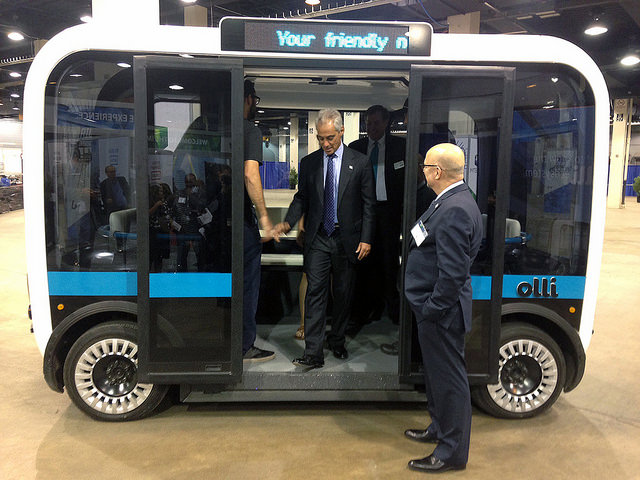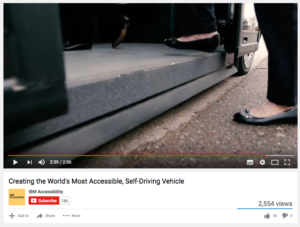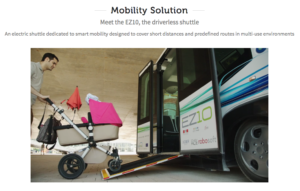The most accessible self-driving bus, or is it?
Discussions about Olli, the “world’s most accessible self-driving bus”, have caught my interest. I was very interested by the technology, and the features it was using to help people with various impairments. There is a lot of promise for what the future of Olli could mean for people with disabilities, but I can’t find any evidence of what has been implemented now, particularly for people with mobility impairments.
 Olli, a self-driving intelligent bus.
Photo by Local Motors CC BY-NC-SA 2.0
Olli, a self-driving intelligent bus.
Photo by Local Motors CC BY-NC-SA 2.0
The point of this post is not to discuss the pros and cons of self-driving vehicles themselves, their safety, range, or other specifications aside from accessibility features.
Accessibility should be considered at all phases of the development process. The experience of many accessibility advocates tells us accessibility is something that tends to be added on after the first, or second, or fifth iteration of a product or website. And it appears that Olli and its makers are guilty of going to market with a product that is not accessible now, even though it might be accessible in the future. I would love to be proven wrong – but until Local Motor responds to my query about the product, I won’t know one way or another.
Don’t get me wrong, I’m excited about the possibilities. I’m happy that accessibility has been discussed. But as it stands today, I don’t see it.
In a promotional video, Olli has been referred to as “the first self-driving cognitive vehicle” by Jay Rogers, CEO and co-founder of Local Motors, the makers of Olli. Mr. Rogers goes on to interact with Olli by having a discussion with it about good places to eat, and Olli even tells him not to forget his umbrella because a storm is coming. Cute. Practical. But not particularly accessible so far.
Elizabeth Woyke wrote about multiple accessibility possibilities in A Self-Driving Bus That Can Speak Sign Language for MIT Technology Review. Although perhaps the title should have said “that could speak sign language”, because it is still a possible future, not a present feature. Nonetheless, Mrs Woyke, the author of the article suggests that Olli could:
- “direct visually impaired passengers to empty seats using machine vision to identify open spots, and audio cues and a mobile app to direct the passenger”
- “guide passengers via a special type of haptic feedback that uses ultrasound to project sensations through the air”
- “the buses could employ machine vision and augmented reality to read and speak sign language via onboard screens or passengers’ smartphones”
- “If the bus were equipped with AR technology, it might be able to respond via a hologram of a person signing”
There’s even a mention that machine vision could identify waiting passengers with walkers or wheelchair and deploy a ramp automatically. Awesome! But…
 ](https://www.youtube.com/watch?v=XQU6bGVRRWE&feature=youtu.be)
The close up of the entrance of Olli shows a chunky floor, but no indication that a ramp is available.
](https://www.youtube.com/watch?v=XQU6bGVRRWE&feature=youtu.be)
The close up of the entrance of Olli shows a chunky floor, but no indication that a ramp is available.
Here’s the thing. I’ve looked closely at still and video images of Olli, and nowhere do I see a ramp. There are no images of Olli having a ramp deployed. There is no indication that a ramp is even already built in to Olli. So you’ll forgive me, a wheelchair user, to be less than enthused about Olli’s accessibility, or rather lack thereof.
Analyzing the images a bit further, I wonder how a ramp could work. Olli’s design doesn’t look all that different from Easy Miles’ EZ10. So I’ll use that as a comparison. The EZ10 does have a ramp. But the floor of the bus is very high, and the ramp is quite short. This makes for a very steep ramp that very few wheelchair users would be able to tackle. It is telling that they show a parent pushing a stroller up the ramp, rather than a wheelchair user struggling to get in.
 Ramps are good for prams, and sometimes wheelchairs, though not in this case.
Ramps are good for prams, and sometimes wheelchairs, though not in this case.
It doesn’t look like either Olli or the EZ10 could lower themselves to reduce the height of the step for ambulatory people with mobility impairments. Which would also reduce the gradient of the ramp, making it more accessible.
The other problem with the ramp on the EZ10 is that it slides out from under the bus’ floor. This design is notoriously flawed. Busses with such ramps in Montréal are nearly always non-functional. The Societé des Transports de Laval actually bolted these kind of ramps in place, so they couldn’t be used at all.
There is great promise to increase accessibility for some people with disabilities. But other elements of accessibility, in particular a functional and usable ramp, are either missing completely or poorly implemented. Don’t tell me these are the “most accessible busses”, self-driving or otherwise.